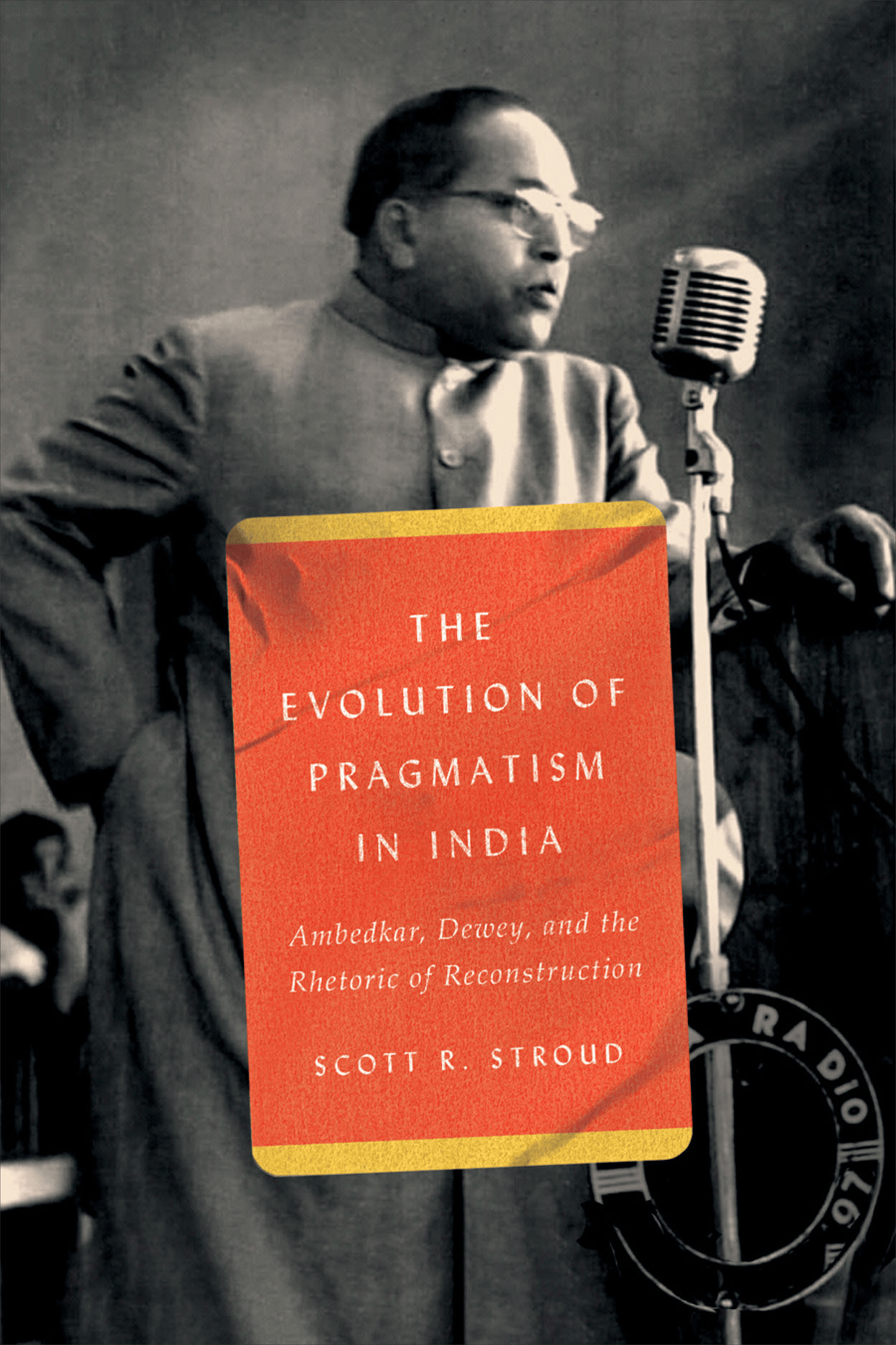
Scott R. Stroud
The Evolution of Pragmatism in India: An Intellectual Biography of B.R. Ambedkar
The University of Chicago Press/Harper Collins India, 2023
300 pages
$29.00 / ₹ 599.00
Reviewed by Nishant Upadhyay
To write an intellectual biography of a figure like Dr. Bhimrao Ramji Ambedkar is nothing short of a Herculean task. One of the greatest intellectuals that India—and the world—ever produced, one could only write Ambedkar’s intellectual biography in specific references to the influences he has had through his eventful life. In acknowledging this challenge well and setting the boundary of his work, Stroud’s evidence and archive-based account focuses on Ambedkar’s relationship and intellectual engagement with John Dewey and his pragmatist thought. In this work, Stroud aims to chart Ambedkar’s reading of—and resistance to Dewey’s pragmatism “as it was encountered at different points by Ambedkar.” In other words, Stroud argues that despite numerous influences on Ambedkar, which require their separate studies, Dewey is the “best documented influence on Ambedkar’s development at Columbia [ . . . ] a vivid inspiration to Ambedkar’s reimagination of Indian traditions, such as Buddhism.” Therefore, Stroud’s Evolution of Pragmatism in India examines Dewey’s pragmatism’s influence on the philosophical ideas underlining Ambedkar’s struggle against caste oppression. However, this book, by no means, is unidirectional; it does justice to Ambedkar’s ideas by showing the points of resistance and Ambedkar’s development of his pragmatism vis-à-vis his years of studying under Dewey at Columbia. In answering the questions of reception, influence, resistance, and reconstruction with archival and textual evidence, this book takes two lines of scholarly approach; first, Stroud examines a philosophical link of Ambedkar’s works in relation to pragmatism. Second, Stroud’s work situates Ambedkar as a rhetor in a long tradition of rhetoric in Indian traditions, where rhetoric is a process of meaning-making and the performance of individual and systemic power.
From Chapter One to Chapter Three, based on archival access, Stroud develops what pragmatism and rhetoric mean in the context of Ambedkar’s formulations. Though Dewey was not the only influence on Ambedkar, Dewey’s ideas, such as that of a democratic community, proved vital for Ambedkar to develop his own outlook. In this vein, Ambedkar came to imagine a democratic community by using and appropriating Dewey’s concepts, particularly of shared interests between community members, through what Dewey once termed “endosmosis.” Stroud masterfully demonstrates how Ambedkar uses these concepts to critique the proto-nation of India, its lack of democratic spirit, and ultimately, the main project of Ambedkar’s life, i.e. the annihilation of the caste system. In Chapters Three and Four, Stroud does a parallel reading through Ambedkar’s existing copies of Dewey’s work, his annotations, and his notes to see which concepts, rhetoric, and meliorisms are apparent and evident in Ambedkar’s speeches and writings, particularly at two historical junctures. First is Ambedkar’s deposition in front of the Southborough Commission, which marks his entry into the Indian political scene. Second, in developing Ambedkar’s more radical ideas, including but not limited to the rejection of Hinduism and its textual basis in the scriptures and Ambedkar’s perhaps most famous text, “the Annihilation of Caste” (1936).
Stroud argues and demonstrates convincingly through his archival consideration that Ambedkar’s ideas of conversion to Buddhism—or at least, outside the fold of Hinduism—begin taking shape in his formative years at Columbia, where a young Ambedkar sought to bridge meliorism, rhetoric, and Buddhism. However, Stroud does not say out loud a fact that undermines his otherwise brilliant analysis: Ambedkar is not just challenging the upper-caste reformers and their soft reforms; he is also claiming and contesting an authority to represent the Dalits away from the upper-caste reformers and claiming an authority for interpreting religious texts by challenging the normative understanding which informs upper-caste reformers. If it were to be read like this, Buddhism—especially Ambedkar’s gradual development of its Navayana strand—becomes a mode to resituate and solidify his authority over the representation of Dalits, not just Mahars, and constitute a proper, critical response against Hindus like Gandhi who always hesitated in addressing the roots of caste.
In studying Ambedkar’s development of thoughts during his time in India, Stroud demonstrates that a post-1935 Ambedkar, after an eventful and formative year for both personal and political reasons, shaped Ambedkar’s cutting-edge criticism of Hinduism using heuristic tools of ideas, such as social endosmosis, which his teacher Dewey only used once, more frequently. In this way, Ambedkar is re-inventing pragmatism in the Indian context as a rhetor, politician, social reformer, and representative of Dalits. Similarly, in Chapter Five, in providing a detailed reading of Ambedkar’s conversion to Buddhism and his vows, Stroud reads his vows, the character of his conversion, and ideas in terms of “enduring pragmatism.” In other words, in using Deweyan pragmatism in the Indian context and integrating it with Buddhism, Ambedkar tailored Dewey’s pragmatic ideas as a long-term, socially transformative philosophy rather than just an instrumental tool serving the objective of social justice.
One of the strengths of Stroud’s work is his brilliant treatment of archives that he is working with. At no point during the book does Stroud let the reader disengage from the archive. Instead, archives that formulate a skeleton of his book allow the reader to follow his arguments and imperative for the book well. However, the writing style of this book is strongly academic and may present some challenges to non-academic audiences who may want to engage with this otherwise excellent research. The way Stroud is arguing how Ambedkar repeatedly appropriates quotes from Dewey presents one of the main issues not addressed in the depth it deserved, making this discussion deeper and concise as a discussion on author-authority, especially, in how Ambedkar used his authority as an author to re-interpret Dewey’s ideas. Ambedkar’s engagement with Dewey’s text happens in two simultaneous ways. The first is as a teacher and mentor who shaped Ambedkar in his formative years as an influential thinker, which Stroud considers in great detail; second, Ambedkar’s use of Dewey’s ideas after Ambedkar’s entry into India’s political scene to develop pragmatist positions against figures like Gandhi, where Dewey’s authority as a philosopher and mentor to Ambedkar would play an important role and could be delved into more.
The role of author-authority, therefore, could be addressed well within the confines of considering the archives. Another issue with the work is while we know Ambedkar’s pragmatism, rhetoric, and meliorism is developed and re-developed in response to the challenges of caste in India, what was the role of race in America—if any—for both Dewey and Ambedkar to test out their ideas early on? In other words, how Ambedkar and Dewey saw the immediate reality of race and why a similar pragmatist critique of race was not developed in Ambedkar and Dewey’s thinking, since racial segregation—especially in the early-twentieth century—performs in the US much like caste segregation does in India. Such considerations would have made Stroud’s work stand out not just in the genre it is currently in, but also making it relevant to the students of American history and society in the twentieth century. With its strengths, this book is a great resource for students who are studying rhetoric, Ambedkar, and anti-caste movements along with a student of South Asian studies in general.

